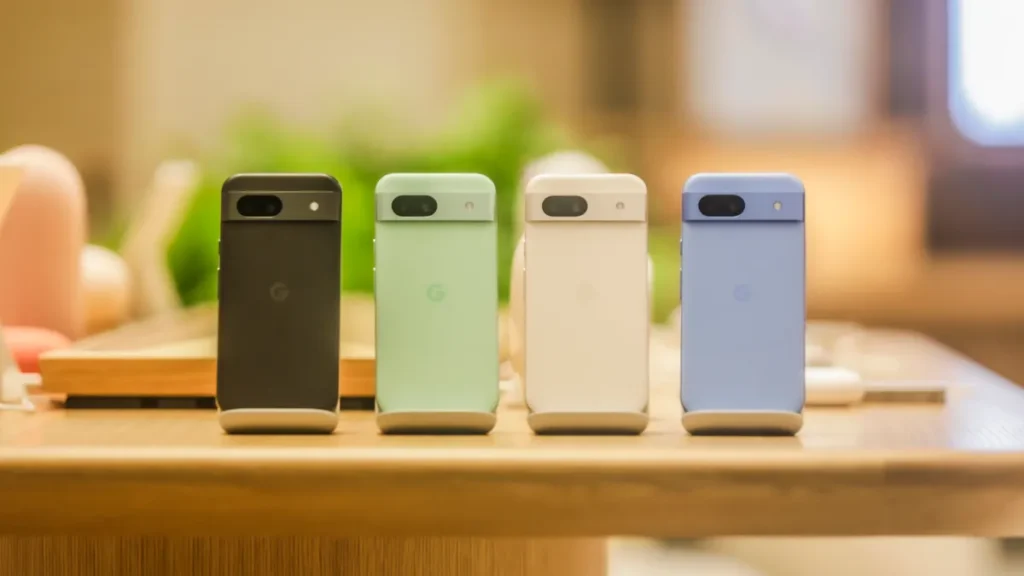Following the highly successful Pixel 7a, which already blurred the lines between mid-range and flagship, Google took things even further with the Google Pixel 8a, launched in May 2024. Priced starting at $499 (same as the 7a’s launch price), the 8a didn’t just inherit the powerful Tensor G3 chip from its Pixel 8 siblings; it also gained a flagship-level display and, crucially, the same industry-leading seven-year software update commitment.
Design: Pixel 8’s Softer Sibling

The Pixel 8a adopted the refined design language of the Pixel 8 series:
- Rounded Aesthetics: It featured the softer, more rounded corners introduced with the Pixel 8, offering a comfortable in-hand feel. The signature Camera Bar was present, matching the matte aluminum frame.
- Build & Materials: Utilized a durable matte composite back and matte aluminum frame, resisting fingerprints better than glossy finishes. The front display was protected by Corning Gorilla Glass 3. IP67 water and dust resistance provided peace of mind.
- Color Options: Launched in Obsidian (black), Porcelain (white), Bay (blue), and a limited edition Aloe (a vibrant green).
- Familiar Layout: Kept the under-display optical fingerprint sensor and camera-based Face Unlock (for lock screen convenience only). As with the 6a and 7a, the headphone jack was absent. While sharing the 6.1-inch screen size with the 7a, the 8a featured noticeably thicker display bezels compared to the Pixel 8.
Hardware: Tensor G3 and a 120Hz Boost
The Pixel 8a delivered impressive hardware upgrades for its class:
- Google Tensor G3: The star attraction was the inclusion of the exact same Tensor G3 chip powering the flagship Pixel 8 and 8 Pro. This brought top-tier performance, especially for AI and machine learning tasks, to the $499 price point.
- RAM & Storage: Came standard with 8GB of fast LPDDR5X RAM (matching the Pixel 8) and offered 128GB or, for the first time in an ‘a’ series phone, 256GB of UFS 3.1 storage.
- Flagship-Caliber Display: The 6.1-inch OLED “Actua Display” received a major upgrade, now featuring a smooth 60-120Hz variable refresh rate and reaching the same impressive brightness levels as the Pixel 8 (1400 nits HDR / 2000 nits peak).
- Battery & Charging: Housed a slightly larger 4492mAh battery compared to the 7a, offering solid all-day performance. Wireless charging (Qi) was retained from the 7a, while wired charging remained at 18W.
- Security: Included the integrated Titan M2 security chip.
Cameras: Proven Hardware, New AI Tricks
While the camera hardware was largely carried over from the Pixel 7a, the Tensor G3 chip unlocked the latest AI-powered features:
- Sensors: Featured the same capable dual rear camera system: a 64MP main sensor (f/1.89, OIS) and a 13MP ultrawide sensor (f/2.2, 120° FOV). The front camera was also the same 13MP sensor.
- AI Camera Features: Thanks to Tensor G3, the Pixel 8a gained access to the innovative features introduced with the Pixel 8:
- Best Take: Select the best facial expressions from a burst of group shots.
- Magic Editor: Perform complex generative AI edits like moving subjects or changing skies.
- Audio Magic Eraser: Remove unwanted background noise from videos.
- Continued excellence with established features like Photo Unblur, Magic Eraser (for objects), Real Tone, Night Sight, and Super Res Zoom (up to 8x).
Software: Seven Years of Support – A Mid-Range First
Launching with Android 14, the Pixel 8a offered Google’s clean and helpful software experience. The truly groundbreaking news, however, was the software support:
- Unprecedented Longevity: The Pixel 8a received the same industry-leading commitment as the flagship Pixel 8 series: seven years of OS updates, security updates, and Feature Drops, promising support all the way until May 2031. This was unheard of for a phone at its price point.
Reception and Legacy: Peak ‘a’ Series Value?
The Google Pixel 8a was met with highly positive reviews, solidifying its place as arguably the best value proposition in the entire smartphone market at launch. Bringing the powerful Tensor G3 chip, a bright 120Hz display, advanced AI editing tools, wireless charging, and especially the seven-year update promise to a $499 phone was remarkable. It offered the core essence of the Pixel 8 experience with very few significant compromises.
Criticisms were generally minor, focusing on the noticeable display bezels (thicker than the Pixel 8) and the relatively slow 18W charging speed. However, the overall package of performance, camera quality, features, and unprecedented software longevity made the Pixel 8a an easy recommendation and a testament to the success of Google’s “a” series strategy.
